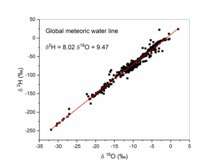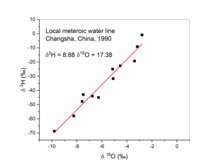Global meteoric water line
The Global Meteoric Water Line (GMWL) describes the global annual average relationship between hydrogen and oxygen isotope (Oxygen-18 and Deuterium) ratios in natural meteoric waters. The GMWL was first developed in 1961 by Harmon Craig, and has subsequently been widely used to track water masses in environmental geochemistry and hydrogeology.

Development and Definition of GMWL
When working on the global annual average isotopic composition of Oxygen-18 and Deuterium (2H) in meteoric water, the geochemist Harmon Craig observed a correlation between these two isotopes. The equation for GMWL was then developed and defined by Harmon Craig[2]:
Where δ18O and δ2H (also known as δD) are the ratio of heavy to light isotopes (e.g. 18O/16O, 2H/1H).
The relationship of δ18O and δ2H in meteoric water is caused by mass dependent fractionation of oxygen and hydrogen isotopes between evaporation from ocean seawater and condensation from vapor[3]. As oxygen isotopes (18O and 16O) and hydrogen isotopes (2H and 1H) have different masses, they behave differently in the evaporation and condensation processes, and thus result in the fractionation between 18O and 16O as well as 2H and 1H. Equilibrium fractionation causes the isotope ratios of δ18O and δ2H to vary between localities within the area. The fractionation processes can be influenced by a number of factors including: temperature, latitude, continentality, and most importantly, humidity,[3][4].

Applications
Craig observed that δ18O and δ2H isotopic composition of cold meteoric water from sea ice in the Arctic and Antarctica are much more negative than that in warm meteoric water from the tropic[2]. A correlation between temperature (T) and δ18O was proposed later[6] in the 1970s. Such correlation is then applied to study surface temperature change over time[7]. The δ18O composition in ancient meteoric water, preserved in ice cores, can also be collected and applied to reconstruct paleoclimate[8][9].
A meteoric water line can be calculated for a given area, named as local meteoric water line (LMWL), and used as a baseline within that area. Local meteoric water line can differ from the global meteoric water line in slope and intercept. Such deviated slope and intercept is a result largely from humidity. In 1964, the concept of deuterium excess d (d=δ2H - 8δ18O)[3] was proposed. Later, a parameter of deuterium excess as a function of humidity has been established, as such the isotopic composition in local meteoric water can be applied to trace local relative humidity[10], study local climate and used as a tracer of climate change[6].
In hydrogeology, the δ18O and δ2H composition in groundwater are often used to study the origin of groundwater[11] and groundwater recharge[12].
References
- IAEA. "Global Network of Isotopes in Precipitation. The GNIP Database".
- Craig, H. (1961). "Isotopic Variations in Meteoric Waters". Science. 133 (3465): 1702–1703. doi:10.1126/science.133.3465.1702. ISSN 0036-8075. PMID 17814749.
- Clark, Ian (2013). Environmental Isotopes in Hydrogeology. Boca Raton, Florida: CRC Press. ISBN 9781482242911. OCLC 1027763963.
- Kendall, Carol; Coplen, Tyler B. (2001). "Distribution of oxygen-18 and deuterium in river waters across the United States". Hydrological Processes. 15 (7): 1363–1393. doi:10.1002/hyp.217. ISSN 0885-6087.
- IAEA (2019). "Global Network of Isotopes in Precipitation. The GNIP Database".
- Merlivat, Liliane; Jouzel, Jean (1979). "Global climatic interpretation of the deuterium-oxygen 18 relationship for precipitation". Journal of Geophysical Research. 84 (C8): 5029. doi:10.1029/jc084ic08p05029. ISSN 0148-0227.
- Fricke, Henry C.; O'Neil, James R. (1999). "The correlation between 18O/16O ratios of meteoric water and surface temperature: its use in investigating terrestrial climate change over geologic time". Earth and Planetary Science Letters. 170 (3): 181–196. doi:10.1016/S0012-821X(99)00105-3. ISSN 0012-821X.
- Johnsen, Sigfús J.; Clausen, Henrik B.; Dansgaard, Willi; Gundestrup, Niels S.; Hammer, Claus U.; Andersen, Uffe; Andersen, Katrine K.; Hvidberg, Christine S.; Dahl-Jensen, Dorthe; Steffensen, Jørgen P.; Shoji, Hitoshi (1997). "The δ18O record along the Greenland Ice Core Project deep ice core and the problem of possible Eemian climatic instability". Journal of Geophysical Research: Oceans. 102 (C12): 26397–26410. doi:10.1029/97jc00167. ISSN 0148-0227.
- Gat, J. R. (1996). "Oxygen and hydrogen isotopes in the hydrologic cycle". Annual Review of Earth and Planetary Sciences. 24 (1): 225–262. doi:10.1146/annurev.earth.24.1.225. ISSN 0084-6597.
- Voelker, Steven L.; Brooks, J. Renée; Meinzer, Frederick C.; Roden, John; Pazdur, Anna; Pawelczyk, Slawomira; Hartsough, Peter; Snyder, Keirith; Plavcová, Lenka; Šantrůček, Jiří (2014). "Reconstructing relative humidity from plant δ18O and δD as deuterium deviations from the global meteoric water line". Ecological Applications. 24 (5): 960–975. doi:10.1890/13-0988.1. ISSN 1939-5582.
- Acheampong, S. Y.; Hess, J. W. (2000). "Origin of the shallow groundwater system in the southern Voltaian Sedimentary Basin of Ghana: an isotopic approach". Journal of Hydrology. 233 (1): 37–53. doi:10.1016/S0022-1694(00)00221-3. ISSN 0022-1694.
- Chen, Jiansheng; Liu, Xiaoyan; Wang, Chiyuen; Rao, Wenbo; Tan, Hongbing; Dong, Haizhou; Sun, Xiaoxu; Wang, Yongsen; Su, Zhiguo (2011). "Isotopic constraints on the origin of groundwater in the Ordos Basin of northern China". Environmental Earth Sciences. 66 (2): 505–517. doi:10.1007/s12665-011-1259-6. ISSN 1866-6280.